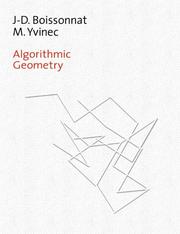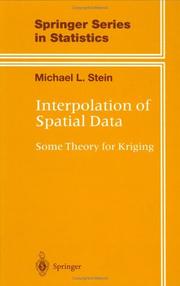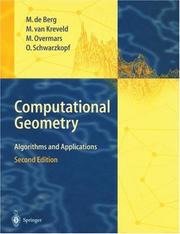| Listing 1 - 7 of 7 |
Sort by
|

ISBN: 9780521565295 9780521563222 0521565294 0521563224 9781139172998 Year: 1998 Publisher: Cambridge Cambridge University Press
Abstract | Keywords | Export | Availability | Bookmark
 Loading...
Loading...Choose an application
- Reference Manager
- EndNote
- RefWorks (Direct export to RefWorks)
The design and analysis of geometric algorithms have seen remarkable growth in recent years, due to their application in, for example, computer vision, graphics, medical imaging and CAD. The goals of this book are twofold: first to provide a coherent and systematic treatment of the foundations; secondly to present algorithmic solutions that are amenable to rigorous analysis and are efficient in practical situations. When possible, the algorithms are presented in their most general d-dimensional setting. Specific developments are given for the 2- or 3-dimensional cases when this results in significant improvements. The presentation is confined to Euclidean affine geometry, though the authors indicate whenever the treatment can be extended to curves and surfaces. The prerequisites for using the book are few, which will make it ideal for teaching advanced undergraduate or beginning graduate courses in computational geometry.
Geometry --- Algorithms --- Géométrie --- Algorithmes --- Data processing --- Informatique --- Algorithms. --- Geografie --- Data processing. --- Topografie --- Geometric Modelling. --- Géométrie
Dissertation
Year: 2024 Publisher: Liège Université de Liège (ULiège)
Abstract | Keywords | Export | Availability | Bookmark
 Loading...
Loading...Choose an application
- Reference Manager
- EndNote
- RefWorks (Direct export to RefWorks)
This thesis provides an analysis on the impact of misfit in implant-supported fixed dental prosthesis, specifically focusing on the challenges and advancements in managing edentulous patients through these prosthetic solutions. The context highlights the historical issues with traditional removable dentures, which often fail to provide satisfactory outcomes due to discomfort, poor retention, instability, and difficulty in mastication. Implant-supported prostheses have emerged over the past two decades as a reliable solution, offering numerous advantages such as decreased bone resorption, enhanced aesthetics, improved tooth position, and increased occlusion function. The study emphasizes the criticality of achieving a passive fit between the prosthesis and the implant components to prevent mechanical complications such as screw loosening, framework fractures, and bone damage. Various impression techniques, including plaster impressions, intraoral cameras, and photogrammetry, are evaluated for their accuracy and suitability. Finite Element Analysis (FEA) is employed to predict the biomechanical behaviour of dental implants under different conditions. This thesis details the process of creating geometric models from 3D scans of prostheses, including post-treatment of the scans and construction of computer-aided models. Mesh accuracy is assessed to ensure reliable simulation results, with discussions on the types of elements used and the convergence of the mesh. The analysis includes different configurations of prostheses (All-on-8, All-on-6 and All-on-4) and materials (titanium and zirconia). The study identifies the most detrimental directions of misfit and their effects on the stress distribution within the prostheses. It is found that the tangent direction is generally the most detrimental, followed by the normal and binormal directions. Stress concentrations are primarily located in the region between access holes. Recommendations are made to minimize errors and improve the fit and performance of implant- supported prostheses. This includes optimizing the design and placement of the implants, utilizing advanced impression techniques, and ensuring proper tightening of screws. This thesis concludes with a discussion on the importance of balancing the stiffness of the prosthesis with that of the bone and the implants to prevent adverse effects on bone health and the overall outcomes of the restoration.
Implantology --- prostheses --- Finite Element Analysis --- 3D scan --- geometric modelling --- geometric reverse engineering --- stiffness --- stress --- misfit --- Ingénierie, informatique & technologie > Ingénierie aérospatiale
Periodical
Abstract | Keywords | Export | Availability | Bookmark
 Loading...
Loading...Choose an application
- Reference Manager
- EndNote
- RefWorks (Direct export to RefWorks)
Civil engineering --- Computer-aided engineering --- Microcomputers --- Data processing --- Computer-aided engineering. --- Microcomputers. --- Génie civil. --- Ingénierie assistée par ordinateur. --- Data processing. --- computer-aided instruction --- visualization --- virtual reality --- artificial intelligence --- machine learning --- smart structures --- parallel processing --- fuzzy logic --- database management techniques --- neural network --- evolutionary computing --- geometric modelling --- knowledge engineeri --- CAE --- Home computers --- Micro computers --- Micros (Microcomputers) --- PCs (Microcomputers) --- Personal computers --- Small computers --- Engineering --- Minicomputers --- Public works
Book
ISBN: 3030705668 303070565X Year: 2021 Publisher: Springer Nature
Abstract | Keywords | Export | Availability | Bookmark
 Loading...
Loading...Choose an application
- Reference Manager
- EndNote
- RefWorks (Direct export to RefWorks)
This open access book gathers contributions presented at the International Joint Conference on Mechanics, Design Engineering and Advanced Manufacturing (JCM 2020), held as a web conference on June 2–4, 2020. It reports on cutting-edge topics in product design and manufacturing, such as industrial methods for integrated product and process design; innovative design; and computer-aided design. Further topics covered include virtual simulation and reverse engineering; additive manufacturing; product manufacturing; engineering methods in medicine and education; representation techniques; and nautical, aeronautics and aerospace design and modeling. The book is organized into four main parts, reflecting the focus and primary themes of the conference. The contributions presented here not only provide researchers, engineers and experts in a range of industrial engineering subfields with extensive information to support their daily work; they are also intended to stimulate new research directions, advanced applications of the methods discussed and future interdisciplinary collaborations.
Technical design --- Production engineering --- Computer-aided design (CAD) --- Engineering Design --- Manufacturing, Machines, Tools, Processes --- Computer-Aided Engineering (CAD, CAE) and Design --- Machines, Tools, Processes --- Open Access --- Additive Manufacturing --- Virtual Prototyping --- Eco-design --- Generative design --- Digitalization in Manufacturing --- Reconfigurable Manufacturing Systems --- 3D Modeling --- Human-machine Interaction --- Sustainable redesign --- Stress analysis and simulation --- Robost design methods --- Topological optimization --- NES design --- Geometric modelling --- Smart tightening
Periodical
Abstract | Keywords | Export | Availability | Bookmark
 Loading...
Loading...Choose an application
- Reference Manager
- EndNote
- RefWorks (Direct export to RefWorks)
Computer. Automation --- Microcomputers --- Computer-aided engineering --- Civil engineering --- Micro-ordinateurs --- Ingénierie assistée par ordinateur --- Génie civil --- Periodicals --- Data processing --- Périodiques --- Informatique --- Computer-aided engineering. --- Microcomputers. --- Génie civil. --- Ingénierie assistée par ordinateur. --- Data processing. --- computer-aided instruction --- visualization --- virtual reality --- artificial intelligence --- machine learning --- smart structures --- parallel processing --- fuzzy logic --- database management techniques --- neural network --- evolutionary computing --- geometric modelling --- knowledge engineeri --- Engineering --- Environmental Sciences --- Information Technology --- Civil Engineering --- Environmental Planning & Studies --- General and Others

ISBN: 0387986294 1461271665 1461214947 Year: 1999 Publisher: New York, N.Y. Springer
Abstract | Keywords | Export | Availability | Bookmark
 Loading...
Loading...Choose an application
- Reference Manager
- EndNote
- RefWorks (Direct export to RefWorks)
Prediction of a random field based on observations of the random field at some set of locations arises in mining, hydrology, atmospheric sciences, and geography. Kriging, a prediction scheme defined as any prediction scheme that minimizes mean squared prediction error among some class of predictors under a particular model for the field, is commonly used in all these areas of prediction. This book summarizes past work and describes new approaches to thinking about kriging.
Stochastic processes --- Kriging. --- Geografie --- Topografie --- Geometric Modelling. --- Probabilities. --- Statistics . --- Geology. --- Geography. --- Earth sciences. --- Probability Theory and Stochastic Processes. --- Statistical Theory and Methods. --- Statistics for Engineering, Physics, Computer Science, Chemistry and Earth Sciences. --- Geography, general. --- Earth Sciences, general. --- Geosciences --- Environmental sciences --- Physical sciences --- Cosmography --- Earth sciences --- World history --- Geognosy --- Geoscience --- Natural history --- Statistical analysis --- Statistical data --- Statistical methods --- Statistical science --- Mathematics --- Econometrics --- Probability --- Statistical inference --- Combinations --- Chance --- Least squares --- Mathematical statistics --- Risk

ISBN: 3540656200 3662042479 3662042452 Year: 2000 Publisher: Berlin : Springer,
Abstract | Keywords | Export | Availability | Bookmark
 Loading...
Loading...Choose an application
- Reference Manager
- EndNote
- RefWorks (Direct export to RefWorks)
Computational geometry emerged from the field of algorithms design and anal ysis in the late 1970s. It has grown into a recognized discipline with its own journals, conferences, and a large community of active researchers. The suc cess of the field as a research discipline can on the one hand be explained from the beauty of the problems studied and the solutions obtained, and, on the other hand, by the many application domains-computer graphics, geographic in formation systems (GIS), robotics, and others-in which geometric algorithms playafundamental role. For many geometric problems the early algorithmic solutions were either slow or difficult to understand and implement. In recent years a number of new algorithmic techniques have been developed that improved and simplified many of the previous approaches. In this textbook we have tried to make these modem algorithmic solutions accessible to a large audience. The book has been written as a textbook for a course in computational geometry, but it can also be used for self-study.
Geometry --- Géométrie --- Data processing. --- Informatique --- 514.16 --- -681.3*F22 --- 681.3*I35 --- Mathematics --- Euclid's Elements --- Geometries over algebras --- Data processing --- Nonnumerical algorithms and problems: complexity of proof procedures; computations on discrete structures; geometrical problems and computations; pattern matching --See also {?681.3*E2-5}; {681.3*G2}; {?681.3*H2-3} --- Computational geometry and object modeling (Computer graphics) --- Geografie --- Topografie --- Geometric Modelling. --- 681.3*I35 Computational geometry and object modeling (Computer graphics) --- 681.3*F22 Nonnumerical algorithms and problems: complexity of proof procedures; computations on discrete structures; geometrical problems and computations; pattern matching --See also {?681.3*E2-5}; {681.3*G2}; {?681.3*H2-3} --- 514.16 Geometries over algebras --- Géométrie --- 681.3*F22 --- Computers. --- Computer science—Mathematics. --- Algorithms. --- Computer graphics. --- Computational complexity. --- Earth sciences. --- Theory of Computation. --- Math Applications in Computer Science. --- Algorithm Analysis and Problem Complexity. --- Computer Graphics. --- Complexity. --- Earth Sciences, general. --- Geosciences --- Environmental sciences --- Physical sciences --- Complexity, Computational --- Electronic data processing --- Machine theory --- Automatic drafting --- Graphic data processing --- Graphics, Computer --- Computer art --- Graphic arts --- Engineering graphics --- Image processing --- Algorism --- Algebra --- Arithmetic --- Automatic computers --- Automatic data processors --- Computer hardware --- Computing machines (Computers) --- Electronic brains --- Electronic calculating-machines --- Electronic computers --- Hardware, Computer --- Computer systems --- Cybernetics --- Calculators --- Cyberspace --- Digital techniques --- Foundations
| Listing 1 - 7 of 7 |
Sort by
|

 Search
Search Feedback
Feedback About UniCat
About UniCat  Help
Help News
News